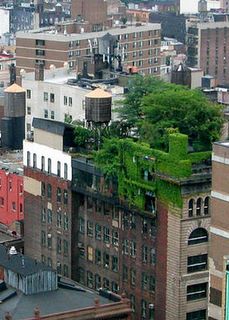
Photograph by Inger Staggs Yancey, owner of Brooklyn Greenroof.
Photo courtesy of Brooklyn Greenroof
Article by Frederick Fooy
Time to hurry, folks, the city of New York is divvying $3 million in grants for rain-catching green infrastructure projects, including green roofs, porous pavement projects and street-level rain gardens, to homeowners, businesses and non-profits. The deadline is fast approaching. You can apply online until April 29.
Our watershed, the Gowanus Canal drainage area, is one of several areas prioritized for funding.
The problem, you see, as strange as it may sound, is rain. With so much pavement in NYC, and so many buildings, there’s not enough places for rain to soak into the ground.
The goal with the grants is to implement one of several methods available to grab rainwater so that it doesn’t run off in mini-floods, grabbing all sorts of detritus, contamination and, especially in South Brooklyn, raw sewage on its path to the Gowanus and local waterways. The grants are available for projects on private property or on public sidewalks, including the curb, where the abutting owner is the sole or co-applicant.
Green infrastructure projects are often fairly affordable and can have a large impact on improving water quality and reducing flooding when implemented in masse. They include bio-retention swales, constructed wetlands (such as one getting built at Brooklyn Bridge Park), green roofs, infiltration bio-swales, infiltration trenches, permeable pavers, porous asphalt, porous concrete, and rain barrels and cisterns (additionally, the city encourages residents to call 311 if they’d like a rain barrel for their property. Collected rain water can be used to water plants.)
Last week, city Department of Environmental Protection officials, and about 40 area residents, turned out for a meeting in the auditorium of P.S. 58 in Carroll Gardens to discuss the city’s green infrastructure plans. The meeting was hosted by City Councilman Brad Lander, who introduced the Commissioner of the DEP, Caswell Holloway. Holloway elaborated on how New York City will be able to improve storm- and rain-water management, and thereby reduce water pollution and flooding issues, through green infrastructure.
Holloway called it “sustainable storm drainage,” and asked for residents’ input.
According to the U.S. Environmental Protection Agency, reducing water runoff in New York City by 10 percent (by grabbing one inch of rainfall through various methods) over 20 years, in addition to other, more traditional improvements to the city sewer system, will save New York City approximately $2.5 billion.
Areas improved with green infrastructure will also improve air quality, absorb noise and, of course, beautify neighborhoods.
“While the plan won’t solve all of our water quality problems, I believe it is an important step in the right direction, and I hope our community will be the most active of any in the NYC in taking action,” Lander said.
According to Brooklyn Greenroof, a local company that builds green roofs with special plants that grab rainwater, brownstones are well-suited for rooftop gardens, since 19th Century construction remains sturdy, and was built to withstand snow without rooftop shoveling. Buildings with green roofs (covered with special plantings that don’t need to be watered), are cooler inside, and require less power to cool in the hot months. Such green roofs also cool the city air. As they absorb rain water, they reduce local water pollution. They also provide an expanded habitat for birds, butterflies and bees, produce oxygen and reduce air pollution.
Although the overall water quality around New York City has seen significant improvements since the 1980s, management of excessive rainwater, which floods sewer drains, creating so-called “Combined Sewer Overflow†(CSO), remains an issue. The sewer systems can’t absorbing CSOs, and the viral video of the nasty overflow into the Gowanus Canal last September is a good reminder of the problem. You can see the video here: overflow.
Every year between 50 and 60 CSOs hit NYC. The problem is compounded by urban terrain. Some 72 percent of New York City is impermeable to rain water.
At the Carroll Gardens meeting, the EDC presented a five-step plan to improve storm water management:
• Implementation of a cost-effective s0-called “grey” infrastructure, such as improvements to the sewer system
• The optimization of existing waste water systems
• The first inch of rain fall is to be absorbed through green infrastructure, and this will decrease polluted water runoff by 10% over 20 years. Precipitation will be caught before it reaches the sewers.
• Adaptive management that will model storm water impacts, measure CSOs and monitor water quality
Further information about the NYC Green Infrastructure Plan can be found here.
